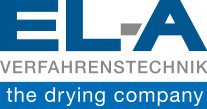Process
In convection belt dryers the product layer, formed as aeratable bulk, will be dried by the transportation through the drying area on a perforated belt. The necessary energy for the evaporation and discharge of the moisture will be delivered by the drying gas flowing through the aeratable product layer. The subdivision of the drying area into several drying chambers allows the adjustment of different
Range of application
Convective belt dryers are suitable for friable, lumpy and performable pasty products.
Products to be handled:
- Pharmaceutical initial products
- Human foodstuff
- Dyestuff and pigments
- Ceramics
- Animal foodstuff
- Super absorber
- Plastics and resins
- Herbicides
- Sewage sludge
- Wood
Advantages
The convective belt dryer has in comparison with other dryer types pretty much advantages:
- No mechanical treatment of the product during drying.
- Easy adaptation of drying or cooling temperatures into different process steps.
- Combination of drying and cooling inside one apparatus.
- Reduced air pollution
- Simple operation and maintenance
- High availability, less wear
Installation/Design
The belt dryers of the standard design range have a modular composition. This design reduces delivery time, costs and spare part storage.
The dryer consists mainly of:
- Product feed module
- Drying or cooling modules
- Product discharge module
Special attention deserves the good accessibility of every module for maintenance and cleaning works. Bearings, motors, gears and control equipment are installed out of the product and drying gas touched area.
As conveying belt guided or controlled belts, designed as plate belts or mesh wire belts, are used.
Product feed module
The module consists of solid bottom and side plates and is strengthened with profiles. The construction incorporates the bearing casings of the guide roller of the transport belt and the correspondent mechanical belt tension device. The front side has doors for maintenance and cleaning purposes.
Drying or cooling module
The construction of the module is divided into drying (cooling) and recirculating air chamber. The bottom and the top of the chamber are insulated construction elements ready for assembly which are connnected through supporting columns. The side sections of the chamber consist of two insulated doors which reach through the total chamber height and will be fixed on the supporting columns. The side sections can be adapted for connection of intake and exhaust air ducting. The inside of the support struts are provided with rails over which the roller chain of the drying belt and the bottom drag link conveyor are able to run. Radiators and recirculation fans are included in the recirculating air chamber, the fan drive being mounted on top of the dryer. Sheet-metal guides ensure correct gas flow in the chamber. Use of bulkhead partitions between the chambers allows the drying process to be subdivided into specific zones, if necessary with different drying and cooling temperatures.
Product discharge module
The module consists of solid bottom and side plates and one ready insulated top element. The construction incorporates the bearing housing of the driving shaft of the conveyer belt and the correspondent belt drive and drag-link conveyor drive. The front side is provided with doors for maintenance and cleaning purposes.
Conveyer belt
There are used endless reinforced metal wire mesh belts or plate belts with canted side plates. The belts are guided on lateral roller chains and driven by chain wheels and a variable gear motor. Additional devices For optimal installation several devices for belt drying plants are available
- Dosing and feeding systems:
Bunker feeder, roller feeder, etc. - Distribution systems:
Oscillating belts, vibration channels, etc. - Pre-formers:
Oscillating press, oscillating roller press, roller preformer - Cleaning of belt and bottom:
Drag-link conveyor, knocker, brushes, high pressure nozzles for cleaning water, air or steam - Conveying systems:
Conveying belts, pneumatical and chain conveyors
Special belt dryers
All dryers of the standard series can be adapted flexible to many requirements of the product. Nevertheless special products, extraordinary places or product requirements need special designed dryers, which following examples show:
- Belt dryers with several conveyor belts for thixotrope products and for small places.
- Special dryers for areas with explosion risks
- Hybrid dryers (microwave/convection) for shorten of the resistance time or for reaction starting
- Hybrid dryers (contact/convection) for pre- and final drying.

